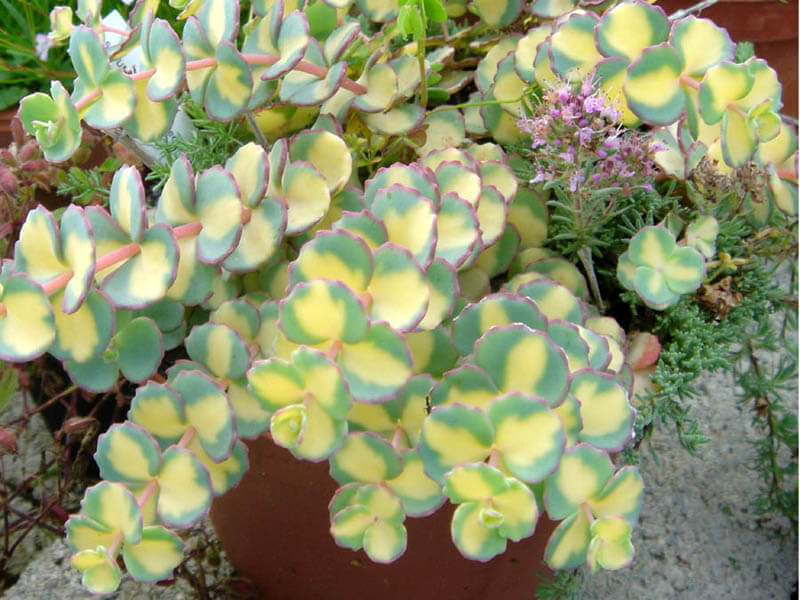
Sedum sieboldii cuidados y reproducción Suculentas, Suculentas colgantes, Cuidado de suculentas
Sedum sieboldii, also known as October Daphne Stonecrop or October Plant, is a low-growing succulent plant that is native to Japan. This stonecrop is beloved for its fall display of deep pink flowers and its arching stems of succulent gray green foliage. 6-12″ tall x 12-15″ wide. Sedum is a large genus of plants and is commonly known as.

Photo 74589 Sedum sieboldii plant lust
El Sedum sieboldii, también conocido como «Planta de piedra» o «Orejas de burro», es una hermosa suculenta que requiere de pocos cuidados. A continuación, te daré algunos consejos prácticos para mantenerla saludable: 1. **Ubicación:** Coloca tu Sedum sieboldii en un lugar donde reciba luz indirecta durante la mayor parte del día.

Sedum Sieboldii The Diggers Club
It is popularly known as Japanese silk or Pilarica, and it is a species native to Japan. It develops creeping or hanging stems depending on where we have it, which reach a length of up to half a meter. From them sprout rounded blue-gray leaves with serrated margins. Blooms in fall.

Cultivo de Sedum Sieboldii cuidado de Pink Sedum Jardín de Nod
Originaria de Japón, esta planta recibe también los nombres populares de Sedo del Japón, Pilarica y October Daphne, este último debido a las preciosas flores que la planta muestra al final de sus tallos en el mes de octubre, en forma de estrella y de un llamativo rosado. Es una suculenta colgante de la familia de las crasuláceas.

Sedum sieboldii 'October Daphne' Stonecrop (3.5" Pot) Little Prince To Go
Watering Sedum sieboldii "October Daphne" has typical watering needs for a succulent. It's best to use the "soak and dry" method, and allow the soil to dry out completely between waterings. Where to Plant "October Daphne" is cold hardy, adding interest and color to winter gardens. It is able to withstand temperatures down to -20°F (-28.9°C).

Sedum Sieboldii Tips, Cuidados y Reproducción
The clusters can reach up to 2.75" wide. Synonymous with Sedum sieboldii. Genus name probably honor Telephus, King of Mysia and son of Hercules. The specific epithet sieboldii honors Philipp Franz von Siebold (1796-1866) a German botanist and physician who collected and studied the flora of Japan extensively.

Sedum Sieboldii Tips, Cuidados y Reproducción
El Sedum sieboldii es la típica, pero no por ello menos interesante, crasa que se cultiva en macetas, sobre todo colgantes, así como en los balcones.Su tamaño, so porte, así como sus flores hacen que sea una planta realmente bonita.

Sedum sieboldii variegata Eden Plantae
Cuidados básicos del Sedum sieboldii. Ubicación: El Sedum sieboldii prefiere lugares con luz solar directa o sombra parcial. Es importante protegerla de las heladas durante el invierno. Riego: Esta planta es resistente a la sequía, por lo que necesita poco riego. Se recomienda regarla solo cuando el suelo esté seco, evitando el exceso de.

Sedum sieboldii 2 Wild Poppies LLC
Description. Hylotelephium sieboldii, formerly known as Sedum sieboldii, is a beautiful low-growing succulent that sends out unbranched stems from a short rootstock. The stems are ascending or hanging over the edges of the pot and grow up to 12 inches (30 cm) long. Leaves are blue-green, up to 0.8 inches (2 cm) in diameter, with a round tip and.

Sedum sieboldii, cuidados de este bonito sedo colgante Ciber Cactus
Height: 6" to 10" inches. Spread: 12" inches. USDA Hardiness Zones: 3 - 9. Foliage: Leaves are rounded fleshy, blue-green early in the growing season gradually turning to deep pink before winter. Flower: Star-shaped rose color pink flowers grow in clusters on 8″ inch stems in late summer through early autumn.

Sedum sieboldii, cuidados de este bonito sedo colgante Ciber Cactus
Sedum sieboldii is an incredibly resilient winter hardy plant that can survive in freeze conditions. Its thick leaves and stems, deep-rooted roots, and ability to store water all contribute to its ability to stay alive even in the coldest of winters. The roots reach deeper into the soil than most other succulents, allowing them to absorb.

Sedum sieboldii 'Mediovariegatum' Riverside Garden Centre
H.Ohba. Description: Sedum sieboldii, sometimes called October daphne, is a trailing deciduous perennial succulent plant, well-distinguished by its creeping stems clad in blue-grey leaves. It is outstanding where the autumn season is long and mild, bearing showy heads of bright pink flowers at the tips of the low-arching stems.

Cultivo de Sedum Sieboldii cuidado de Pink Sedum Jardín de Nod
Sedum sieboldii: A fast growing deciduous cactus / succulent or groundcover with blue foliage and pink flowers in summer and fall. It contributes glaucous texture to the garden. Attractive to butterflies. To grow well, it prefers sun - mostly sun and regular - low water. Drought tolerant once established. Prefers to be dry when dormant. Grows best in well-drained, lean, average and gritty soil.

Sedum Sieboldii Tips, Cuidados y Reproducción
El Sedum sieboldii es una planta suculenta perteneciente a la familia Crassulaceae, nativa de Japón. Es una planta de crecimiento lento que puede alcanzar una altura de hasta 30 cm. Las hojas son redondeadas, de color verde oscuro y tienen una textura carnosa. Esta planta es muy fácil de cuidar y es ideal para los jardineros principiantes.

Sedum sieboldii cuidados y reproducción Guía completa
Rich in many qualities, Sedum sieboldii (October Daphne Stonecrop) is a low growing, deciduous perennial with many seasons of interest. Forming a rounded mound, the plant sends out horizontal branches from the central crown bearing whorls of rounded leaves, less than 1 in. wide (2.5 cm).

Sedum sieboldii cuidados y reproducción Guía completa
October Daphne (Sedum Sieboldii) is a resilient plant that prefers full sunlight and a temperature that is only slightly below freezing. They need to be protected from the strong sun and high temperatures when they live in hotter climates. These plants grow well on rocky soils in their natural habitat where they are primarily groundcovers.